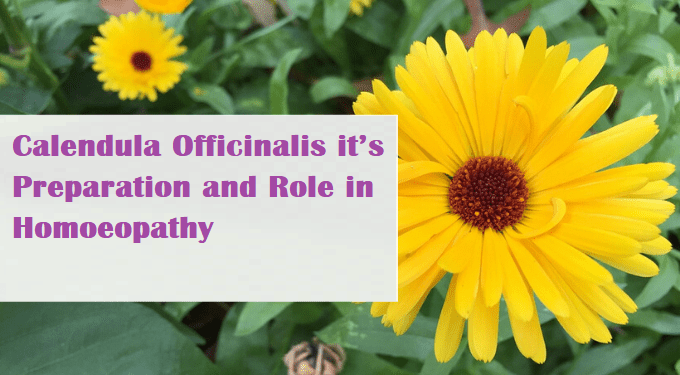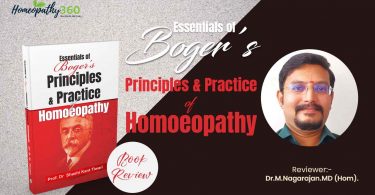
Introduction-
Dr. Franz in 1838 introduced Calendula officinalis in the homoeopathic practice. Calendula officinalis, commonly known as marigold, is indeed a versatile and widely used plant with a long history of medicinal and ornamental use across various regions.[1][2]
Here are some key points about Calendula officinalis and its common names.[1][2][3]
- Scientific Classification:[1]
- Family: Asteraceae (Compositae)
- Genus: Calendula
- Species: Calendula officinalis
- Common Names:[1]
- African Marigold
- Calendula
- Common Marigold
- Garden Marigold
- Marigold
- Pot Marigold
- Zergul (India)
- Butterblume (Germany)
- Chin Chan Ts’ao (China)
- Galbinele (Romania)
- Ringblomma (Sweden)
- Geographical Usage:
- Calendula officinalis is used medicinally and cultivated in Europe, China, the United States, and India.
Traditional Uses:[4]
Europe
Leaves: the leaves of Calendula officinalis are considered resolvent (able to dissolve or eliminate something, often used in the context of swelling or inflammation) and
diaphoretic (promoting sweating). This suggests that they may have been used for conditions involving inflammation and to induce sweating.
Flowers: The flowers of Calendula are used as a stimulant (increasing physiological activity), antispasmodic (relieving spasms or muscle contractions), and
emmenagogue (promoting or regulating menstrual flow). England
In England, a decoction (a preparation made by boiling a substance, usually a plant) of the flowers was used as a posset drink for the treatment of measles and smallpox.
Posset was a warm, spiced milk drink often used as a remedy for various ailments.
The fresh juice of Calendula flowers was used as a remedy for jaundice (a liver condition causing yellowing of the skin and eyes), costiveness (constipation), and suppression of menstrual flow.
India
In India, Calendula florets are used in ointments for treating various skin conditions, including wounds, herpes, ulcers, frostbite, skin damage, and scars. This suggests the plant’s wound-healing and skin-soothing properties.
The leaves of Calendula, when prepared as an infusion (a liquid made by steeping a substance in hot water), are used externally for treating varicose veins.
Medicinal Uses:[1]
- Calendula has a long history of medicinal use, primarily for its antiinflammatory, antifungal, and wound-healing properties.
- It is often used topically in the form of creams, ointments, or salves for skin conditions such as burns, cuts, rashes, and insect bites.
- Some people also use calendula internally as a herbal remedy for digestive issues and menstrual discomfort, although it’s more commonly used topically.
Preparation of Calendula:[3] Old Method-[3]
Prepared undert Class 1
Ratio of Drug juice and alcohol- 1:1 Part used- fresh leaves Procedure-
- The fresh leaves are cut into the small pieces with a polished steel knife on a clean chopping board and pounded to a pulp in mortar and pestle.
- The pulp is now enclosed in a new linen cloth and juice is expressed by a means of a press or by ringing a cloth.
- Expressed juice is kept in a glass jar where equal quantity by wt. of strong alcohol is added to it.
- The mixture is shaken vigoursly for some time and poured in a well stopped bottle.
- This mixture is allowed to stand for 8 days in cold dark place and is the filtered.
- Then it is poured in a clean phial provided with a best quality of new non porous velvet cork.
Drug power- ½
New method- In new method Calendula Offincinalis id prepared using maceration.[3][5]
- Habitat: It is cultivated in India.
- History and authority: Allen’s Encyclopedia.
- Mat. Med. Vol. II, 419.
- Parts used: Fresh flowering tops and leaves. Moisture content of fresh flowering tops and leaves is 600 ml per 100 g solids.
- Preparation: (a) Mother Tincture φ Drug strength 1/10 Calendula Officinalis, moist magma containing Solids 100g and plant moisture 600 ml 700 g Strong Alcohol 437 ml to make one thousand milli-liters of the Mother Tincture.
- Potencies: 2x to contain one part tincture, four parts Purified Water, five parts Strong Alcohol. 3x and higher with Dispensing Alcohol
Maceration[5] Apparatus:
- Macerating Jar with Lid,
- Drug material,
- Menstruum,
- Chopping board and knife
Procedure
- Maceration process shall be used in such cases where the material requires ample time for the extraction of medicinal properties. Gummy and mucilaginous substances and those having much viscid juice which do not allow alcohol to permeate the mass readily as in the process of percolation should be macerated in the preparation of tincture.
- The plant moisture shall be ascertained as described in the Appendix X and the quantity of menstruum, shall be calculated accordingly.
- Reduce the drug material to a pulp (or maintain it in its natural state if not reducible) and then place it in a macerating jar (preferably make up of a stainless steel or glass).
- Add the precalculated quantity of menstrum so as to cover the whole mass of the drug substance. Keep the Jar well corked in a cool dark place free from dust, odour, heat or direct sunlight. Agitate the whole mass once a day and keep for a period of two weeks.
- Decant the supernatant liquid and press out the residue through a press or a piece of clean linen cloth. Measure the whole fluid and if found less than the calculated quantity, add the fresh menstruum to the mass and press it again so as to make the required volume.
- In case of viscid or mucilaginous material, where the alcohol does not act fully on the substance, the process can be modified as follows : Task half the quantity of pre-calculated vehicle and add to the pulp. Keep it for three to seven days and press out the tincture thereafter. Triturate mass which remains behind with washed sand or with green glass powder, twice the bulk of this mass and add to it the remaining half of the vehicle. Percolate the whole material as described below. Add sufficient quantity of alcohol to the percolated volume so as to make the prescribed volume. This necessitates because of the contraction of volume where two liquids of different specific gravity are mixed.[5]
Homoeopathic Use Of Calendula officinalis
- Clinical Uses -Abscess. Balanitis. Breast, suppurating; nodosities in. Bubo. Burns. Carbuncle. Chilblains. Deafness. Eyes, inflamed. Fever. Fistula. Glandular swelling. Jaundice. Labour. Nails, pulp of, inflamed. Nipples, sore. Suppuration. Tetanus. Ulcers. Uterus, inflammation of; cancer of; offensive discharge from. Varicosis. Whitlow. Wounds.[6]
- Calendula belongs to the same family as those other great Vulneraries Arnica and Bellis perennis. The special kind of wounds indicating its use are lacerated wounds and suppurating wounds. It is the homoeopathic antiseptic-it restores the vitality of an injured part, making it impregnable against the forces of putrefaction.[6]
- Traumatic affections: to secure union by first intention and prevent suppuration. In all cases of loss of soft parts when union cannot be effected by means of adhesive plaster. External wounds with or without loss of substance; torn and jagged looking woulds; postsurgical operation; to promote healthy granulation and prevent excessive suppuration and disfiguring scars. Traumatic and idiopathic neuroma (Cepa); neuritis from lacerated wounds (Hyper.); exhausted from loss of blood and excessive pain. Rupture of muscles or tendons; lacerations during labor; wounds penetrating articulations with loss of synovial fluids. Wounds: with sudden pain during febrile heat; constitutional tendency to erysipelas (Psor.); old, neglected, offensive; threatening gangrene (Sal. ac.). Ulcers: irritable, inflamed, sloughing, varicose; painful as if beaten (Arn.); excessive secretion of pus. Calendula is almost specific for clean, surgical cuts or lacerated wounds, to prevent excessive suppuration.[7]
- A most remarkable healing agent, applied locally. Useful for open wounds, parts that will not heal, ulcers, etc. Promotes healthy granulations and rapid healing by first intention. Haemostatic after tooth extraction. Deafness. Catarrhal conditions. Neuroma. Constitutional tendency to erysipelas. Pain is excessive and out of all proportion to injury. Great disposition to take cold, especially in damp weather. Paralysis after apoplexy. Cancer, as an intercurrent remedy. Has remarkable power to produce local exudation and helps to make acrid discharge healthy and free. Cold hands.[8]
- External wounds and lacerations, with (or without) loss of substance. The wound is raw and inflamed ; is painful, as if beaten
; the parts around the wound become red, with stinging in the wound during the febrile heat.[9]
References
- A systematic review of Calendula officinalis extract for wound healing Running Title: Calendula officinalis extract for wound healing.
- Muzumdar KP. Pharmaceutical science in homoeopathy & pharmacodynamics. Vol.
106. New Delhi, India: B Jain;
- Mandal PP, Mandal B. A textbook of homoeopathic pharmacy. 3rd ed. Delhi, India: New Central Book Agency; 2012.
- Muley BP, Khadabadi SS, Banarase NB. Phytochemical Constituents and
Pharmacological Activities of Calendula officinalis Linn (Asteraceae): A Review. Trop J Pharm Res [Internet]. 2009;8(5). Available from:
http://dx.doi.org/10.4314/tjpr.v8i5.48090
- Government of India, Ministy Of Health. Homoeopathic Pharmacopoeia of India, Combined Volume I to V , Revised and augmented. NEW DELHI; 2016.
- Calendula [Internet]. Materiamedica.info. [cited 2023 Dec 5]. Available from:
https://www.materiamedica.info/en/materia-medica/john-henry-clarke/calendula
- calendula [Internet]. Materiamedica.info. [cited 2023 Dec 5]. Available from: https://www.materiamedica.info/en/materia-medica/henry-c-allen/calendula
- Boericke W. calendula officinalis [Internet]. Materiamedica.info. [cited 2023 Dec 5]. Available from: https://www.materiamedica.info/en/materia-medica/william-
boerickeshort/calendula-officinalis
- Calendula officinalis [Internet]. Materiamedica.info. [cited 2023 Dec 5]. Available from: https://www.materiamedica.info/en/materia-medica/adolf-zur-
lippe/calendulaofficinalis




